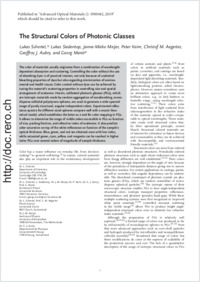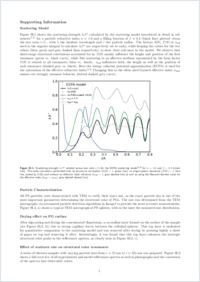The structural colors of photonic glasses
- Schertel, Lukas Department of Chemistry, University of Cambridge, UK - Fachbereich Physik, Universität Konstanz, Germany - Physics Institute, Universität Zürich, Switzerland
- Siedentop, Lukas Fachbereich Physik, Universität Konstanz, Germany
- Meijer, Janne-Mieke Fachbereich Physik, Universität Konstanz, Germany - Institute of Physics, University of Amsterdam, The Netherlands
- Keim, Peter Fachbereich Physik, Universität Konstanz, Germany
- Aegerter, Christof M. Physics Institute, Universität Zürich, Switzerland
- Aubry, Geoffroy J. Fachbereich Physik, Universität Konstanz, Germany - Département de Physique, Université de Fribourg, Switzerland
- Maret, Georg Fachbereich Physik, Universität Konstanz, Germany
-
17.05.2019
Published in:
- Advanced Optical Materials. - 2019, p. 1900442
English
The color of materials usually originates from a combination of wavelength‐dependent absorption and scattering. Controlling the color without the use of absorbing dyes is of practical interest, not only because of undesired bleaching properties of dyes but also regarding minimization of environmental and health issues. Color control without dyes can be achieved by tuning the material's scattering properties in controlling size and spatial arrangement of scatterers. Herein, calibrated photonic glasses (PGs), which are isotropic materials made by random aggregation of nonabsorbing, monodisperse colloidal polystyrene spheres, are used to generate a wide spectral range of purely structural, angular‐independent colors. Experimental reflectance spectra for different sized spheres compare well with a recent theoretical model, which establishes the latter as a tool for color mapping in PGs. It allows to determine the range of visible colors accessible in PGs as function of size, packing fraction, and refractive index of scatterers. It also predicts color saturation on top of the white reflectance as function of the sample's optical thickness. Blue, green, and red are obtained even with low index, while saturated green, cyan, yellow, and magenta can be reached in higher index PGs over several orders of magnitude of sample thickness.
- Faculty
- Faculté des sciences et de médecine
- Department
- Département de Physique
- Language
-
- English
- Classification
- Physics
- License
- License undefined
- Identifiers
-
- RERO DOC 327005
- DOI 10.1002/adom.201900442
- Persistent URL
- https://folia.unifr.ch/unifr/documents/308028
Other files
Statistics
Document views: 51
File downloads:
- aub_scp.pdf: 241
- aub_scp_sm.pdf: 85

